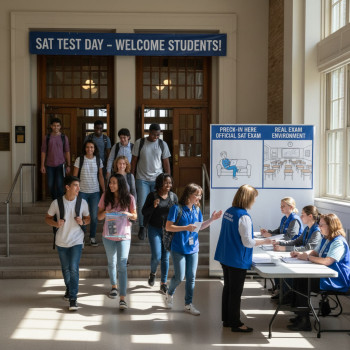How Parents Can Support Teens Studying for the Digital SAT in Small Towns
Watching your teenager prepare for the Digital SAT can feel like watching them learn to ride a bike for the first time: thrilling, a little nerve-wracking, and full of small moments that matter more than they seem. If you live in a small town, you may wonder how to build the right environment, find helpful resources, and keep motivation steady when local options feel limited. The good news: parent influence, encouragement, and practical planning can bridge most gaps. This guide walks you through a warm, practical roadmap — what to do, how to talk to your teen, and where tailored support (including Sparkl’s personalized tutoring) can help — all in a way that fits the rhythms of small-town life.

Why parental support matters — especially in a small town
College admissions and standardized tests can feel impersonal, but the journey toward the Digital SAT is deeply personal. Research and experience show that a teen’s performance is influenced not just by study materials, but by emotional stability, routine, access to quality feedback, and encouragement — all things parents are uniquely positioned to provide.
In small towns, students may lack easy access to test prep centers, weekend classes, or large peer groups focused on the SAT. That’s not a disadvantage if parents step in as organizers, champions, and thoughtful collaborators. Your role isn’t to become a tutor (though you can help with logistics and morale); it’s to create the conditions for success: a steady schedule, realistic goals, reliable tech, and alternatives for one-on-one help when local options are scarce.
Start with a conversation — not a lecture
Before you buy books or sign up for prep programs, open a calm, honest conversation. Teens respond better when they feel heard and involved. Ask open-ended questions and listen:
- What are your college goals? Which schools do you like and why?
- How do you feel about the Digital SAT — confident, nervous, indifferent?
- What times of day do you study best? What distractions get in the way?
Frame the test as one important step — not the single determinant of their future. When teens sense pressure, they can freeze. When they sense partnership, they take ownership.
Build a realistic study plan together
A shared plan turns vague anxiety into focused action. Tailor the plan to your teen’s schedule and personality. Here’s a simple structure you can adapt:
- Assessment week: take one full-length official practice test to set a baseline.
- Weekly rhythm: 3–5 study sessions per week, 45–90 minutes each depending on school and activities.
- Monthly checkpoints: review progress, adjust goals, and celebrate small wins.
Let’s put that into a sample 12-week layout so it feels concrete.
Sample 12-week study plan (flexible)
| Weeks | Focus | Weekly Goal | Parent Role |
|---|---|---|---|
| 1 | Baseline & Structure | Take official practice test; set score goals | Help schedule test; review results together |
| 2–4 | Content Review: Math fundamentals & Reading strategies | Target weak areas; complete topic-focused practice | Provide quiet study time; pair practice with tutoring if needed |
| 5–8 | Timed practice & strategy | Weekly timed sections; analyze mistakes | Encourage routine; celebrate improvements |
| 9–11 | Full tests & polishing | Take 2–3 full digital practice tests; focus on pacing | Help manage schedule so test days feel calm |
| 12 | Final prep & rest | Light review, rest, and test logistics check | Be present and reassuring; ensure healthy sleep |
Tech and logistics: get the digital test basics right
The Digital SAT is taken on a device, so ensuring reliable tech is essential — but you don’t need fancy gear. In small towns, internet speed or device availability can be concerns; solve these early so tech problems don’t become test-day stressors.
- Device: Confirm whether your teen will use a school-issued laptop, a personal device, or a loaner. Practice on the same kind of device whenever possible.
- Battery and charger: Keep a charger and a backup plan (power bank, full charge overnight).
- Internet: If bandwidth is limited, arrange a quiet time for downloads/updates or find a local library or community center with reliable Wi‑Fi for practice sessions.
- Practice interface: Make sure the student is comfortable with digital tools like highlighting, flagging questions, and using the on-screen calculator.
Small-town workaround example: if your home Wi‑Fi spikes during evenings, schedule practice sessions in the morning or drive to a nearby high school library on weekends. Planning like this reduces last-minute panic.
Pacing, timing, and the power of small drills
Many students struggle less with content and more with pacing. Build timing skills with short, focused drills — 15–30 minute sessions that mimic digital timing patterns. These tiny wins accumulate and boost confidence more than one marathon study night ever will.
- Short drills: 15-minute vocabulary-in-context or algebraic manipulation sets.
- Timed sections: Practice one reading passage or a math block under time limits; review immediately.
- Review loops: After a practice block, spend 10 minutes reviewing errors and cataloging why they happened (careless, concept, misunderstanding).
As a parent, you can help by timing sessions, offering breaks, and celebrating steady improvement. Praise strategy over raw scores: “You used an educated guess when time ran out — great call.”
Finding targeted help when local options are limited
In small towns, in-person SAT coaches may be rare. That’s where remote, personalized tutoring fills a gap. One-on-one tutors offer real-time feedback, tailored lesson plans, and accountability. When you’re evaluating options, consider tutors who provide:
- Diagnostic tests and individualized study plans.
- Clear explanations and step-by-step progress checks.
- Flexible scheduling to fit school and activities.
Sparkl’s personalized tutoring can be an excellent fit for small-town families: it offers 1-on-1 guidance, tailored study plans, expert tutors, and AI-driven insights that pinpoint where practice will have the biggest payoff. If a local class isn’t available, a consistent weekly session with a skilled tutor can replicate the benefits of an in-person program while letting your teen study from home.
Homework help vs. test prep: how to draw the line
It’s easy to confuse day-to-day homework support with SAT preparation. Both matter, but they require different approaches. Homework builds subject knowledge and grades; test prep builds test-specific skills: pacing, multiple-choice strategy, and familiarity with the exam’s digital format.
Keep these distinctions in mind when planning time and resources. A balanced schedule might include after-school help for math class twice weekly, plus two focused SAT sessions per week aimed at strategy and timed practice.
Motivation, accountability, and real-world rewards
Motivation waxes and wanes — especially when there’s no large test-prep culture nearby. Make the process meaningful by connecting SAT prep to real goals and small celebrations:
- Use college goals: “If you want to major in X, higher scores can open scholarship doors.”
- Schedule mini-rewards: a favorite meal, a weekend hike, or a small purchase after a milestone test.
- Create accountability rituals: weekly check-ins over coffee, a progress chart on the fridge, or a study buddy arrangement with a friend at school.
Remind your teen that growth happens in increments. Celebrate effort and specific improvements: “You shaved two minutes per section — that will add up.”
Stress, sleep, and mental health
Test preparation isn’t only cognitive — it’s emotional. Teens under pressure can develop sleep problems, anxious thoughts, or perfectionist patterns. As a parent, watch for signs of burnout: increased irritability, procrastination, declining grades in other subjects, or avoidance of practice tests.
- Prioritize sleep: consistent bedtimes help memory consolidation and focus.
- Encourage movement: short daily exercise resets mood and attention.
- Teach coping techniques: breathing exercises, short breaks, and perspective statements like “one test won’t define everything.”
If anxiety becomes persistent, consider professional counseling or pausing the schedule to rebuild confidence. The goal is steady progress, not exhaustion.
Practical sample dialogues — how to be encouraging without nagging
Here are small scripts you can adapt. Use them as starting points for supportive conversations that respect teens’ autonomy.
- When they avoid a practice test: “I notice the practice tests have been on hold. Want me to help you block out an hour this weekend so it feels less like a big thing?”
- After a disappointing score: “That result stings — I get it. Can we look at the questions that were hardest and see if there’s a pattern to attack next?”
- When celebrating progress: “I’m proud of how you stuck with those timed sections. You’ve improved your pacing — that’s a smart, sustainable change.”
How to use practice tests wisely (and not kill motivation)
Practice tests are gold because they reveal patterns. But too many full tests too often can drain enthusiasm. Use full-length digital practice tests strategically:
- Begin with one for a diagnostic baseline.
- Use one every 2–3 weeks during heavy prep phases to monitor progress.
- Simulate test day conditions for at least one practice: quiet space, timed sections, and minimal interruptions.
After each test, spend time reviewing mistakes. The most valuable part isn’t the score — it’s the learning you extract from errors. Work with your teen to categorize incorrect answers and track whether they are careless mistakes, timing problems, or knowledge gaps.
Local resources that can be repurposed
Small towns often have useful community assets that aren’t labeled “test prep.” Repurpose these for studying:
- Public library study rooms for quiet practice sessions.
- High school teachers who can offer occasional guidance or content review during office hours.
- Community centers or churches that can host group study sessions or proctored practice tests.
Parents who network with other families can create peer study groups that provide accountability and social support — a huge morale boost for teens who feel isolated in their prep journey.
When to consider test-optional schools or retesting
Many colleges now use test-optional policies, but that doesn’t make the decision simple. A strong SAT score can still open scholarship opportunities and strengthen an application, especially if grades or extracurriculars are less competitive. Consider retesting when:
- Your teen shows upward score trends on practice tests after targeted study.
- There’s a realistic plan to address weak areas before the next test date.
- Scholarships available to the student have score thresholds that they could reach with more preparation.
Discuss options with your teen and, if helpful, with a college counselor or a trusted tutor who understands the admissions landscape.
How Sparkl can fit naturally into a small-town strategy
When local test prep options are limited, one-to-one remote tutoring is a practical solution. Sparkl’s personalized tutoring brings expert tutors and AI-driven insights to students wherever they are. Typical benefits for small-town families include:
- Tailored study plans that focus on high-impact areas rather than generic content.
- Flexible scheduling to match school and activity calendars.
- Expert tutors who provide step-by-step feedback and real-time strategy coaching.
- Progress tracking so parents and students can see measurable improvement.
Used judiciously, these services complement what you do at home: structure, encouragement, and a steady rhythm of practice.
Costs, value, and how to budget
Preparing for the SAT can involve costs: official practice materials, practice tests, and tutoring. In small towns, consider cost-effective mixes:
- Use free official practice tests and digital resources for baseline work.
- Invest in targeted tutoring focusing on the highest-leverage areas rather than broad packages.
- Trade services with other families (study group hosting, shared practice test proctoring) to reduce costs.
Think of tutoring not as an expense but as an investment in targeted improvement. A few months of focused tutoring that raises a score enough to unlock scholarship money often pays for itself.
Final week checklist — keep it simple
In the final week before test day, shift to maintenance and confidence-building. Here’s a compact checklist you can use with your teen:
- Take one light practice section 3–4 days before the test — no heavy studying.
- Confirm the testing device, battery, and any required software or login details.
- Plan transportation and a quiet space to arrive early on test day.
- Prioritize sleep and balanced meals; avoid last-minute cramming.
- Share reassuring words and remind them: effort beats anxiety.
Parting thought
Small-town life offers advantages sometimes overlooked: close-knit community, fewer distractions, and opportunities to build deep, trusting relationships. As a parent, your steady presence, thoughtful planning, and willingness to seek out targeted help can transform the SAT from a looming obstacle into a manageable milestone. Celebrate steady progress, lean on thoughtful remote supports when needed (including Sparkl’s personalized approach), and remember that the skills your teen gains during this process — discipline, problem-solving, and resilience — will matter long after test scores are submitted.

If you keep the big picture in mind, respect your teen’s pace, and combine consistent home routines with targeted expert help, the Digital SAT becomes less of a solitary hurdle and more of a shared project. That partnership — the steady “we’ve got this” — is the most powerful tool you can give a teen from any town.
Good luck, and remember: small-town students have everything they need to succeed with the right plan and a lot of heart.

















No Comments
Leave a comment Cancel